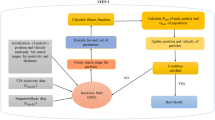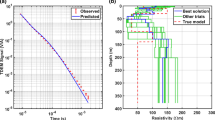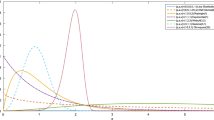Abstract
DC resistivity inverse problems are ill-posed. For the Vertical Electrical Sounding method the acceptable solutions lie in very narrow elongated-shape regions in the model space. To characterize this ensemble of solutions is a central question. In a Bayesian framework this issue is solved adopting as solution the so-called model posterior probability distribution. However, due to the nonlinearity of the problem, this distribution is not explicitly known, or it is difficult to calculate. Therefore, algorithms that efficiently sample the model space according to it (importance sampling) are very desirable. The main goal of this paper is to numerically explore the performance of binary genetic algorithms as posterior importance sampling strategies. Their behavior will be firstly analyzed using 2D synthetic posterior test functions bearing the relevant properties of the real geo-electrical inverse problem. The conclusions will be again checked through the histogram reconstruction of parameters in a synthetic VES case, and eventually, in a real, higher dimensional, sea-water coastal intrusion problem, by comparing the results with those obtained with a theoretically correct Metropolis-Hasting importance sampler (simulated annealing without cooling). Percentile curves are introduced as an effective tool for risk assessment. We show that binary genetic algorithms perform well under very general assumptions. When the roulette wheel is the selection method used, mutation is over 10%, and the algorithm does not incorporate elitism. The results do not depend on the values of the remaining tuning parameters. Finally, to improve the efficiency of the sampling strategy, we introduce a binary genetic algorithm with oriented search space. This is done with the help of linearization of the forward operator and singular value decomposition around the maximum posterior estimate. It is shown, also, that the logarithmic model parameterization is adequate for this task.
Similar content being viewed by others
References
Cary PW, Chapmann CH (1988) Automatic 1-D waveform inversion of marine seismic refraction data. Geophys J R Astron Soc 93:527–546
Chib S, Greenberg E (1995) Understanding the Metropolis–Hastings algorithm. Am Stat 49(4):327–335
Chunduru RK, Sen MK, Stoffa PL (1996) 2-D resistivity inversion using spline parameterization and simulated annealing. Geophysics 61(1):151–161
Curtis A, Lomax A (2001) Tutorial: prior information, sampling distributions and the curse of dimensionality. Geophysics 66(2):372–378
Fernández Alvarez P (2004) Análisis y resolución numérica de un problema inverso en geofísica medioambiental. Aplicación al caso de los sondeos eléctricos verticales. PhD thesis, Universidad de Oviedo
Fernández Alvarez P, Fernández Martínez JL, Menéndez Pérez CO (2004) A posteriori inference of model parameters in a geophysical inverse problem using GA. In: Soft methodology and random information systems. Advances in soft computing, pp 709–711
Geman S, Geman D (1984) Stochastic relaxation, Gibbs distribution and the Bayesian restoration of images. IEEE Trans Pattern Anal Mach Intell 6:721–741
Goldberg DE (1989) Genetic Algorithms in search, optimization and machine learning. Addison-Wesley, Reading
Gosh DP (1971a) The application of linear filter theory to the direct interpretation of geoelectrical resistivity sounding measurements. Geophys Prospect 19:192–217
Gosh DP (1971b) Inverse filter coefficients for the computation of apparent resistivity standard curves for a horizontally stratified earth. Geophys Prospect 19:769–777
Gouveia W, Scales J (1997) Resolution of seismic waveform inversion: Bayes vs Occam. Inverse Probl 13:323–349
Hansen C (1998) Rank deficient and discrete ill-posed problems. Numerical aspects of linear inversion. Library of Congress, Philadelpia
Holland JH (1975) Adaptation in natural and artificial systems. University of Michigan Press, Ann Arbor
Instituto Geológico Minero de España (1988) Prospección geoléctrica en la zona de Águilas (Murcia). Internal report
Joines J, Houck C (1994) On the use of nonstationary penalty functions to solve constrained optimization problems with GA. In: IEEE international symposium on evolutionary computation, Orlando, FL, pp 579–584
Johanssen HK (1977) A man/computer interpretation system for resistivity soundings over a horizontally stratified earth. Geophys Prospect 25:667–691
Koefoed O (1979) Geosounding principles. Elsevier, Amsterdam
Koren A, Mosegaard K, Landa E, Thore P, Tarantola A (1991) Monte Carlo estimation and resolution analysis of seismic background velocities. J Geophys Res 96:289–299
Maillet R (1947) The fundamental equations of electrical prospecting. Geophysics 12:529–556
Malinverno A (2000) A Bayesian criterion for simplicity in inverse problem parameterization. Geophys J Int 140:267–285
Michalewicz A (1992) Genetic algorithm + data structures = evolution programs. Springer, Berlin
Mosegaard K (1998) Resolution analysis of general inverse problems through inverse Monte Carlo sampling. Inverse Probl 14:404–426
Mosegaard K, Sambridge M (2002) Monte Carlo Analysis of inverse problems. Inverse Probl 18:29–54
Mosegaard K, Tarantola A (1995) Monte Carlo sampling of solutions to inverse problems. J Geophys Res B 100(7):12431–12447
Orellana E (1982) Prospección geoeléctrica en corriente continua. Paraninfo, Madrid
Pekeris CL (1940) Direct method of interpretation in resistivity prospecting. Geophysics 5:31–42
Rothman DH (1985) Nonlinear inversion statistical mechanics and residual statics corrections. Geophysics 50:2794–2796
Scales JA, Snieder R (1997) To Bayes or not to Bayes. Geophysics 62(4):1045–1046
Scales JA, Snieder R (2000) The anatomy of inverse problems. Geophysics 65(6):1708–1710
Schwarzbach C, Börner RU, Spitzer K (2005) 2D inversion of direct current resistivity data using a parallel, multi-objective genetic algorithm. Geophys J Int 162:685–695
Sen MK Bhattacharya BB, Stoffa PL (1993) Nonlinear inversion of resistivity sounding data. Geophysics 58:496–507
Stefanesco SS, Schlumberger C, Schlumberger M (1930) Sur la distribution électrique potentielle autour d’ une prise de tèrre ponctuelle dans un terrain à couches horizontales. J Phys Radium 1:132–140
Author information
Authors and Affiliations
Corresponding author
Rights and permissions
About this article
Cite this article
Fernández Alvarez, J.P., Fernández Martínez, J.L. & Menéndez Pérez, C.O. Feasibility Analysis of the Use of Binary Genetic Algorithms as Importance Samplers Application to a 1-D DC Resistivity Inverse Problem. Math Geosci 40, 375–408 (2008). https://doi.org/10.1007/s11004-008-9151-y
Received:
Accepted:
Published:
Issue Date:
DOI: https://doi.org/10.1007/s11004-008-9151-y




